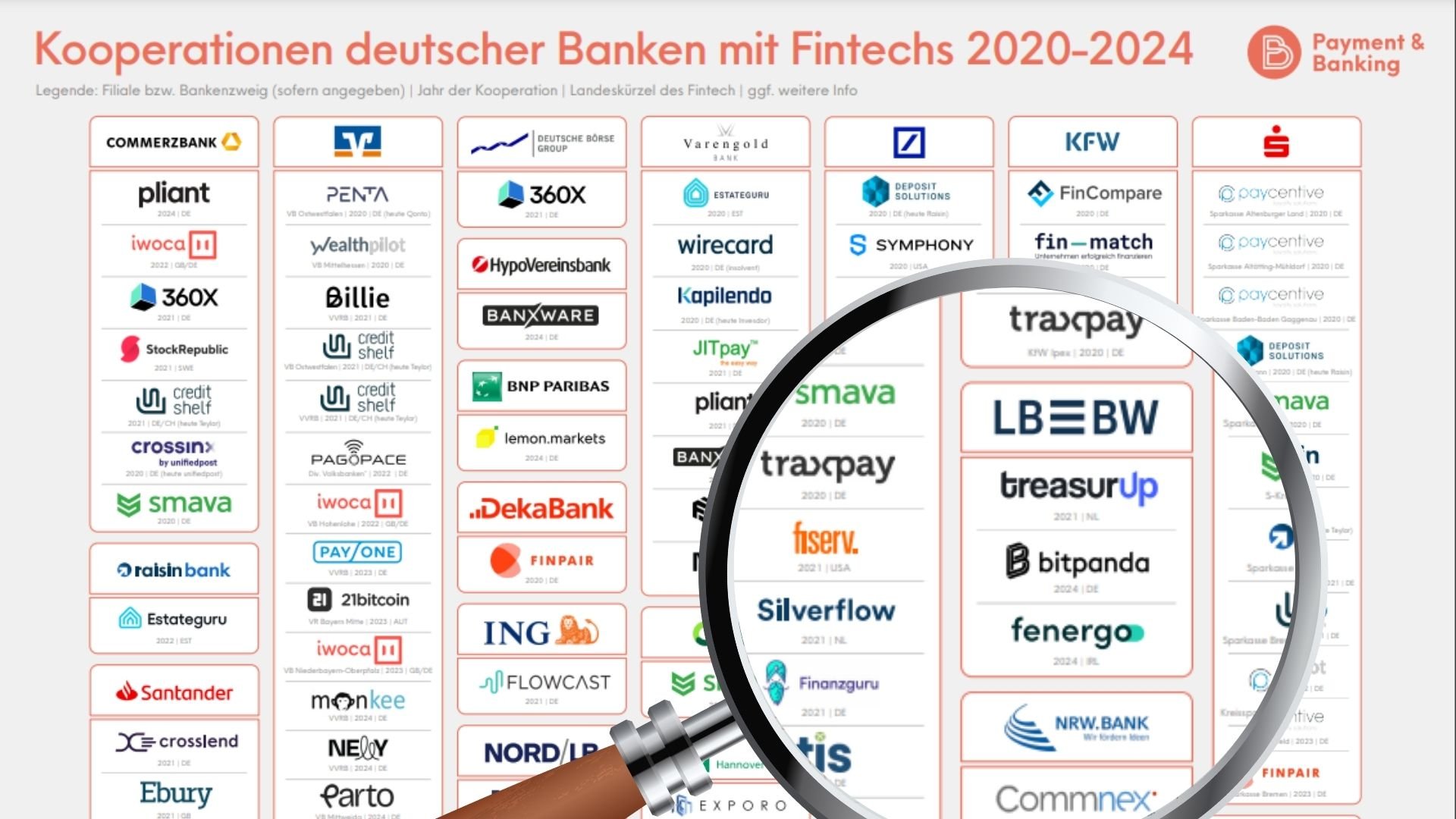Im Firmenkundengeschäft verschieben sich die Fronten – aber die Banken scheinen das nicht zu sehen. Wenn sie auch in Zukunft relevant bleiben wollen, müssen sie sich neuen Herausforderungen öffnen und das alte Selbstbild ablegen.
In seinem Meisterwerk „The Sun Also Rises“ hält Ernest Hemingway ein kurzes Geschäftsgespräch zwischen zwei Charakteren fest: „Wie sind Sie bankrott gegangen?“, fragt der eine, worauf der andere antwortet: „Auf zwei Arten. Erst allmählich, dann ganz plötzlich“. Genau diese Dynamik beschreibt wohl den Wandel der meisten Branchen, wie ihn Außenstehende wahrnehmen. Vielleicht hört man von einem neuen Anbieter oder einer Innovation, ohne überhaupt zu wissen, worum es sich dabei handelt, bis scheinbar über Nacht eine als sicher geglaubte Branche völlig anders aussieht – siehe Twitter, Instagram oder Uber. Oft geschieht diese Art von Veränderung so abrupt und unerwartet, auch weil die Innovatoren lange nicht als Konkurrenz, Wettbewerber oder Marktteilnehmer erkannt oder ernst genommen wurden.
Banken, die sich auf einem neuen digitalen Markt behaupten wollen, in dem ambitionierte Marktteilnehmer lauern, die nicht dem traditionellen Bankgeschäft angehören, müssen Veränderungen erkennen und darauf reagieren, solange diese sich noch im Frühstadium befinden. An diesem Punkt befindet sich heute das klassische Firmenkundengeschäft. Wenn Banken vermeiden wollen, Relevanz und Kund:innen an schnell wachsende Unternehmen wie Square und Shopify zu verlieren, denen ein anderes System zugrunde liegt als ihr eigenes, dann sollten sie schnell handeln.

Marktteilnehmer müssen sich auf die Lösung von Problemen konzentrieren, anstatt weiter auf veraltete und gescheiterte Strategien zu setzen, mit denen sie bislang ihre Kund:innen bespielt haben.
Herausforderung: Das Selbstbild der Banken
Das Firmenkundengeschäft verändert sich heute vor allem deshalb, weil sich die Kund:innen selbst durch eine Vielzahl neuer Anwendungen und Dienste verändern. Das ermöglicht es ihnen, etwa Finanzvorgänge, die für das Kerngeschäft relevant sind, an nahtlos integrierte Lösungen wie Square, Personio oder Hubspot auszulagern. Diese Dienste sind für Unternehmer:innen attraktiv, weil sie Einstiegshürden senken und es ihnen ermöglichen, sich auf ihr Kerngeschäft zu konzentrieren, etwa die Verbesserung ihrer Produkte und der Kund:innenerfahrung. Ähnliche Veränderungen sind im Firmenkundengeschäft im Gange, die allmählich – und bald plötzlich – Gestalt annehmen.

Corporate Banks haben auf die Veränderungen lange Zeit nicht reagiert und ihre Rolle im Geschäftsökosystems nicht ausreichend analysiert. In der Vergangenheit versuchten sie, die Geschäftswelt mehr oder weniger erfolgreich davon zu überzeugen, dass sie „maßgeschneiderte“ Lösungen benötigen und „die Banker:innen selbst“ das Herzstück der Geschäftsbeziehung und des Geschäftsprozesses sind. Dies mag zwar traditionell zutreffen – wirkt aber angesichts zahlreicher neuer Softwareangebote für Unternehmer:innen zunehmend nicht mehr zeitgemäß.
Die bittere Wahrheit ist, dass Banken sich zwar als Förderer der Wirtschaft sehen, Unternehmer:innen und Manager:innen sie jedoch heute eher als das direkte Gegenteil betrachten: als „Gatekeeper“, die von ihnen verlangen, noch vor dem eigentlichen Start langwierige, bürokratische Verfahren zu durchlaufen, die in der Regel nichts mit dem Kerngeschäft eines angehenden Unternehmens zu tun haben.
Allmähliche Verschiebung in ein scheinbar unattraktives Segment
Im klassischen Zyklus der digitalen Transformation verändern sich die Märkte zunächst in Nischensegmenten – gut definierten, aber etwas unscheinbaren Segmenten, die für die großen etablierten Banken im Allgemeinen unattraktiv sind. Im Bankensektor ließen sich diese Veränderungen in den vergangenen zehn Jahren etwa im Zahlungsverkehr, in den fragmentierten Landschaften des Gastgewerbes, im E-Commerce und in den professionellen Dienstleistungen beobachten. Da die Banken selbst diese Wertschöpfungsbereiche als unattraktiv, unbedeutend und unsicher ansahen, trieb stattdessen eine Reihe von Startups Innovationen voran, um unterversorgte Segmente zu besetzen. Dass sich die Banken durch diese Entwicklungen nicht bedroht fühlen, liegt vermutlich vor allem daran, dass sie deren Potenzial noch nicht erkannt haben.
Allmählich bereit, plötzlich digital zu werden
Die Ergebnisse lassen sich vielerorts beobachten. Heute kann die Gründerin eines Unternehmens – etwa eine Restaurantbetreiberin – Square nicht nur für die Annahme von Zahlungen nutzen, sondern auch für die Verwaltung von Buchungsfunktionen, Bestellmanagement und Liefersystemen – und bekommt damit Einblicke in Daten, die zur Optimierung des Unternehmens beitragen. Über Square können Unternehmer:innen gar ein einfaches Girokonto einrichten und kleine Kredite aufnehmen, um das Tagesgeschäft zu finanzieren. Unternehmer:innen, die ein E-Commerce-Business gründen möchten, werden dagegen wahrscheinlich Shopify nutzen, um die Website zu erstellen, mit dem Ziel, die Integration so einfach wie möglich zu gestalten. Und durch die Integration von Stripe kann Shopify heute viele der Bankgeschäfte abwickeln, um die sich einst die Kredithäuser kümmerten.
Auch wenn Gründer:innen wahrscheinlich immer noch ein Bankkonto benötigen, werden sie nicht das gesamte Spektrum an traditionellen Bankdienstleistungen benötigen. Die Anzahl der komplexen Aufgaben, die die neuen Anbieter für diese Unternehmer:innen über ihre digital integrierten Plattformen mit minimalen Einstiegshürden abwickeln, ist ein Angebot, mit dem traditionelle Banken nicht konkurrieren können. Die einstigen Außenseiter werden zu schlafenden Giganten, die nach und nach Wertschöpfungspools schlucken, um plötzlich als führende Bankdienstleistungen für kleine und mittlere Unternehmen aufzutreten.

Doch die Gefahr lauert noch an anderer Stelle. Denn auch Big Tech macht sich bereit, in diese Wertschöpfungspools einzusteigen. Seit langem halten sich Gerüchte, dass Apple eine Reihe von Lösungen für KMUs einführen könnte – ein naheliegender nächster Schritt für ein Unternehmen mit einer so breiten und tiefen Hardware-Durchdringung. Wenn ein kleines Unternehmen in der Kreativbranche Apple-Geräte verwendet, spricht nichts dagegen, gleich eine ganze Reihe von Softwarelösungen in diese Geräte einzubauen. Apple und Goldman Sachs sind bereits vor drei Jahren eine strategische Partnerschaft für Apple Pay eingegangen und bieten eine digitale Mastercard an. Kund:innen bekommen so beim Kauf eines Apple-Produkts gleich eine klassische Bankdienstleistung angeboten.
Das Kundengeschäft ist in diesem Transformationszyklus weiter als das Firmenkundengeschäft, aber auch das wird sich bald ändern. Unternehmen wie Spryker positionieren sich schon jetzt als spezialisierte Anbieter, die in der Lage sind, komplexere B2B-Transaktionen für den Einsatz bei größeren Unternehmen zu digitalisieren. Gleichzeitig bewegt sich die Industrie hin zu digitalen Betriebssystemen in allen Bereichen, von der wissenschaftlichen Forschung bis hin zu Logistik, Mobilität und Energie. Dies sind Branchen, aus denen die Banken einen Großteil ihrer derzeitigen Einnahmen beziehen, und sie müssen in der Lage sein, sich in diese Betriebssysteme einzuklinken, um als relevante und informierte Partner bestehen zu können.
Auch deutsche Tech-Player erkennen das Potential im Corporate Banking für sich. SAP hat für etwa 1 Milliarde Euro den e-Invoicing- und SupplyChain-Financing-Anbieter Taulia übernommen. Damit wird SAP als branchenfremdes Unternehmen zum Wettbewerber und verschafft sich einen massiven Datenvorsprung gegenüber traditionellen Banken. Von nun an sammelt SAP – deutlich tiefgreifender als es heute Banken tun – alle Rechnungsdaten, Zahlungsziele und Konditionen ihrer Kund:innen.
Durch Innovation die Herausforderung eines neuen Marktes meistern
Banken, die sich gegen die Bedrohung durch Digital-First-Unternehmen behaupten wollen, müssen ihr Angebot an Kund:innen neu definieren – und eine ähnliche Strategie verfolgen wie die „Nicht“-Banken, mit denen sie konkurrieren. Anstatt sich auf Selbstvermarktung zu konzentrieren, sollten Banken die zentralen geschäftlichen Herausforderungen in einer oder mehreren Branchen identifizieren und diese Probleme durch die Entwicklung überlegener Technologien und Kund:innenerlebnisse lösen.

In den meisten komplexen Branchen gibt es nach wie vor viele ineffiziente manuelle Prozesse, die die Betreiber:innen Milliarden kosten und sich für diejenigen, die in der Lage sind, Tools und Systeme zu entwickeln, um sie auf skalierbare Weise zu verbessern und zu automatisieren, in Wertschöpfungspools verwandeln lassen.
Doch um diese Chancen zu erkennen und zu nutzen, muss man aufmerksam bleiben. Banken sollten ihre Kund:innen einbeziehen und sich von ihnen sagen lassen, welche Probleme sie lösen müssen, und dann ihre Ressourcen, ihr Ansehen und ihre etablierten Beziehungen nutzen, um diese Lösungen zu entwickeln. Dabei müssen sie offen dafür sein, dass die Ergebnisse häufig nur wenig mit dem zu tun haben werden, wie das traditionelle Bankwesen heute funktioniert.
Die Banken werden sich von einem eher transaktionsorientierten Geschäftsmodell zu einem zirkulären Modell bewegen müssen, indem sie verschiedene Unternehmen und Branchen digital miteinander verbinden und kollaborative Geschäftsmodelle ermöglichen. Banken können sich durch die Nutzung ihres Know-hows im Umgang mit der Regulierungslandschaft in eine Position bringen, in der sie zu Anbietern digitaler Infrastrukturen für bestimmte Sektoren werden können – während sie weiterhin über Zahlungen und/oder Kredite Geld verdienen.






